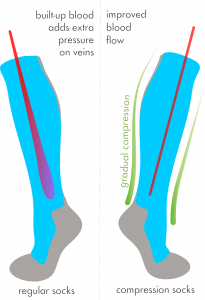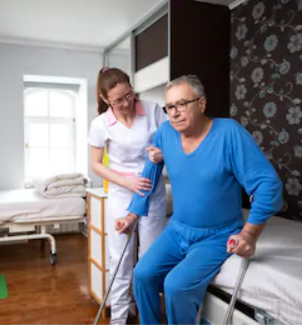
You may have heard of TEDs socks before, perhaps being talked about by your nurse or doctor.
If you have a history of blood clots, have recently had surgery, are bedridden or are an older adult, these socks may be right for you.
In fact, TEDs socks were specifically designed with customers like yourself in mind.
What Are TEDs Socks?

The “TED” in the title stands for thromboembolism-deterrent. Initially designed by Covidien, they are now being manufactured by Medtronic as a minimally invasive way to treat blood pressure issues.
They are designed to prevent deep vein thrombosis (DVT) and pulmonary embolisms by applying graduated pressure.
TEDs socks are worn after surgery to halt the formation of blood clots in the legs (deep vein thrombosis). They are often recommended for patients who can’t move around freely after surgery.
They feature a custom graduated pressure pattern: 18mmHg at the ankle region, 14mmHg at the calf region, 8mmHg at the popliteal area, 10mmHg at the lower thigh and 8mmHg at the upper thigh region.
This clinically proven compression pattern increases the blood flow velocity of the deep venous system.

They are beloved and trusted in the medical community. Since they are clinically validated and their effectiveness is backed by numerous studies, both physicians and patients feel at ease about using anti-embolism legwear.
Just like regular compression socks, they are available in a variety of styles including thigh-high and knee-high length, closed-toe and open-toe.
Created with patients in mind, they are made of a mix of nylon and spandex. This ensures both durability and comfort. If you’d like, you can choose a color that will match your daily style
The Purpose of TED Hose

The primary purpose of Ted hose is to prevent the clotting of blood and any swelling in your legs. They are designed to provide relief from venous thromboembolism (VTE). This is why they are essential if you are bedridden or are recovering from surgery.
Many post-operative individuals or patients that are susceptible to blood clots wear these socks as a prevention method. People in need of improved lymphatic drainage would also benefit from wearing these graduated compression socks.
Are there limitations to when they should be worn? Let’s explore when and how to wear them in the following sections.
How to Wear These Stockings?
Prepare Your Legs and Feet

- A health care provider will need to measure your leg to get the right size parameters for your personal pair of anti-embolism legwear. They may also teach you and your caregiver the proper way to put on and take off the socks.
- Lie down with your legs on a pillow for a minimum of 15 minutes before putting on the socks.
- Sprinkle powder on your ankles to assist in easing the socks onto your legs. You may use talcum powder or cornstarch. Ask your healthcare provider which powder would be best for you if you have any skin sensitivities.
Tips for Wearing Them

- Place just your foot into the sock. Utilize short and quick pulls, bringing the loose material up from around your ankle to the knee or thigh.
- Sometimes arthritis or limited strength in the hands can make it difficult to put on your socks. If this applies to you, speak with your physician or nurse about your options. You may need to use a stocking donner.
- Ensure that your socks are in place, and do not allow your socks to roll down at the top. A roll may cut off circulation in the area around it.
- Ensure that the fabric has been smoothed out. Any ridges or folds in the fabric may disrupt the flow of blood to your feet and legs. The folds could also lead to additional pressure on your skin, causing skin irritation.
- Wear them as directed by your physician.
- Check your toes for temperature and color changes every four hours each day. If you notice any changes in your toes, talk to a nurse or physician.
After You Remove Them
- Wash your legs and check for rashes or skin irritations whenever you take off your stockings.
- Wash the socks with mild soap and warm water. You might be directed to wear another pair of TEDs socks while you wash the other pair.
Replacing Them
- Purchase new socks if the ones you have do not fit correctly or become damaged.
- Consult your doctor if your feet swell in response to using the TEDs socks. If you are unable to move your feet, are experiencing leg pains and cramps or have any concerns about your condition, touch base with your nurse or doctor.

The Features and Health Benefits of Wearing TED Stocking

- Clinically proven to limit the risk of thromboembolic complications.
- Help in preventing pulmonary embolisms and DVT.
- Universal design that can accommodate either leg.
- Graduated compression application.
- Excellent for lymphatic drainage.
- Closed-toe or open-toe design.
- They have graduated compression.
- Trusted in the medical field.
- Various lengths and colors.
- Promote blood flow.
How Long to Wear Them for After Surgery
You will be advised by your health care professional or surgeon on how long you should be wearing them after surgery.
Generally, when they are recommended after surgery, they should be worn night and day, until you can freely move. Usually, they aren’t meant for long-term use.
They are to be worn as a short-term preventative measure. Once your complication has been treated or fully addressed, wearing TEDs socks will no longer be needed.
Who Should Use Them After Surgery?
As discussed earlier, TEDs socks are primarily designed for immobile patients and those that spend most of their time sitting or lying in bed.

The surgeon in charge of your care will assist you to ascertain if wearing them is for you. When admitted to the hospital, your risk of developing DVT will be checked thoroughly by medical staff to confirm if you need TED compression socks or not. You may also request to wear them if you are able to leave the hospital the same day as you are being operated on.
Your risk of having Deep Vein Thrombosis (DVT) may increase if you:
- Are having surgery on the knee, abdomen, hips or legs.
- We will be required to have a general anesthetic for more than 1.5 hours.
- Are required to be a lot less mobile after undergoing surgery.
Limiting Your Risk of Deep Vein Thrombosis

Wearing quality TEDs socks is an ideal way to limit your risk of DVT. You can also reduce your risk by drinking an adequate amount of fluids and moving about as soon as you are able to after the surgery.
They come with a relaxed inspection hole at the bottom of the foot for easy monitoring of your vital signs and circulation. Watching out for any signs of decreased circulation can help you catch DVT if it does happen.
Precautions
They aren’t recommended for all individuals.
If you suffer from peripheral artery disease, the blood supply to your legs is already profoundly compromised. As a result, wearing TEDs socks or compression socks may worsen your condition. Do not wear them if you have peripheral artery disease.
A Simple Way to Put Them On

If you are bedridden in a hospital or care facility, donning and removing your TEDs socks will likely be done by medical staff available to help you. Stick to the guidelines provided by your medical support worker if you are applying them on your own.
Let’s analyze the simple way to wear these stockings:
Size

Before you can put them on, you must first know your sizing. Getting accurate measurements of your leg is essential for a comfortable fit.
A nurse will measure the circumference of the widest portion of your thigh or calf, as well as the length of your leg from the back of the knee to the base of the heel.
If you are wearing knee-high ones, they should rest one inch below the knee. If you are wearing thigh-high ones, they should rest two inches beneath the widest part of the thigh.
Some wearers have noticed their socks do not stay up well and must be continually adjusted all day. This is a sign that you are wearing the wrong size and may need to be re-measured. Talk to a medical professional if your socks aren’t the required size.
Bagging

As a post-operative patient, you may find you do not have the strength to put on or remove the tight socks on your own.
One trick to putting them on with ease is to place a plastic bag over your foot before applying the sock.
Your TEDs socks will comfortably slide over the plastic.
Powder
A second option for putting them on is to use talcum powder, cornstarch or baby powder. Sprinkle your legs and feet with powder, and pour some powder inside the socks as well.
Roll them up. Begin by fitting the sock just over the toes, working it over the heel and then pulling it up the leg. Smooth out any creases in the sock fabric.
Considerations
- TEDs socks that must be worn continually will still need to be removed for bathing.
- Ensure your legs and feet are fully dry before putting them on.
- Check that your socks are in good condition, are dry and are clean.
- Do not apply lotion to your legs prior to wearing them.
Conclusion

We’ve explored how they can aid in keeping your legs and circulation healthy after surgery or while bedridden. Without them, your blood can pool in the veins, resulting in swelling or even a clot.
If you have an upcoming surgery or are currently in a state of immobility, you too can benefit from wearing them.
Connect with your doctor or caretaker to have the proper measurements taken, then try out your own pair of TEDs socks.
